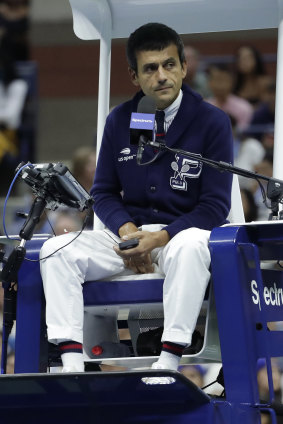As anyone playing tennis today will tell you, facing Serena Williams on court is more than just a match – it is a career milestone. Williams' journey from concrete courts in the tough Los Angeles neighbourhood of Compton to victory in packed stadiums around the world has extended the horizons of women of colour and female athletes as surely as boxer Muhammad Ali and baseball player Jackie Robinson once changed the world beyond their chosen arenas. If you doubt that, ask the woman who beat her in last weekend's US Open final, Naomi Osaka.
As Osaka has pointed out, a defining feature of Williams the champion is her defiant aggression – an aggression that tennis, long a bastion of male chauvinist attitudes, used to consider the proper domain of men. So it is perhaps understandable that those who have followed Williams through her battles for equal pay for women and the racism she has experienced see the dramatic scenes surrounding her recent defeat as part of a wider allegory.
This attitude fails a number of tests, the first of them being factual. The idea that chair umpire Carlos Ramos reacted in the way he did because Williams is a woman overlooks the fact that he has enforced the code of tennis just as stringently with the game's top men; the claim that men get away with behaviour that should earn them code violations is not sustainable on the evidence; and the idea that this was Williams "letting off steam" and "being who she is" should never be used to obscure the fact that sometimes she has been capable of ugly, threatening behaviour towards people with far less power than herself.

Chair umpire Carlos Ramos during the US Open final.Credit: AP
The second test it fails is that of respect for the sport. The suggestion of one columnist that Ramos' position in a high chair during the match was itself a symbol of entrenched privilege overlooks the very reason for such positioning: the official is required to have a perspective on the match that the committed competitors cannot. It was the breaching of this divide that worried so many during Nick Kyrgios' second-round victory at the tournament, but it is every bit as troubling to hear a top player threaten an official with a career sanction over their application of the rules.
Williams might well argue that rules themselves are not above scrutiny, and a series of glaring injustices she experienced during her 2004 US Open quarter-final against Jennifer Capriati ushered in a new system allowing players to challenge umpires. Yet Williams' insistence that she does not get coached in contravention of the rules and her coach's admission that such coaching is commonplace are hard to reconcile. Certainly there is a case to reconsider the rules surrounding coaching at Grand Slam tournaments. But the time for that is not in the middle of a major final.
Which brings us to the third and final test of Williams' actions, one she introduced herself by reminding Ramos that she has a daughter. The idea that being a mother means Williams can't possibly be a cheat, or that she should be given special consideration before being sanctioned, is absurd. But as her journey into parenthood continues, she will find more than once that she has to rethink what it means to set an example – even if you are already an inspiration to so many.
- A note from the editor – Subscribers can get Age editor Alex Lavelle's exclusive weekly newsletter delivered to their inbox by signing up here: www.theage.com.au/editornote